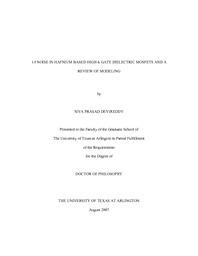
ATTENTION: The works hosted here are being migrated to a new repository that will consolidate resources, improve discoverability, and better show UTA's research impact on the global community. We will update authors as the migration progresses. Please see MavMatrix for more information.
Show simple item record
| dc.contributor.author | Devireddy, Siva Prasad | en_US |
| dc.date.accessioned | 2008-04-22T02:41:11Z | |
| dc.date.available | 2008-04-22T02:41:11Z | |
| dc.date.issued | 2008-04-22T02:41:11Z | |
| dc.date.submitted | August 2007 | en_US |
| dc.identifier.other | DISS-1858 | en_US |
| dc.identifier.uri | http://hdl.handle.net/10106/681 | |
| dc.description.abstract | For next generation MOSFETs, the constant field scaling rule dictates a reduction in the gate oxide thickness
among other parameters. Consequently, gate leakage current becomes a serious issue with very thin SiO2 that is conventionally used as gate dielectric since it is the native oxide for Si substrate. This has driven an industry wide search for suitable alternate 'high-k' gate dielectric that has a high value of relative permittivity compared to SiO2 thereby presenting a physically thicker barrier for tunneling carriers while providing a high gate capacitance. Consequently, it is essential to study the properties of these novel materials and the interfaces that they form with the substrate, gate or other dielectrics in a multi-level stack.
The main focus of this work is the 1/f noise that is specifically used as a characterization tool to evaluate the performance of high-k MOSFETs. Nevertheless, DC and split C-V characterization are done as well to obtain device performance parameters that are used in the noise analysis.
At first, the room temperature 1/f noise characteristics are presented for n- and p-channel poly-Si gated MOSFETs with three different gate dielectrics- HfO2, Al2O3 (top layer)/HfO2 (bottom layer), HfAlOx. The devices had either 1 nm or 4 nm SiO2 interfacial layer, thus presenting an opportunity to understand the effects of interfacial layer thickness on noise and carrier mobility. In the initial study, the analysis of noise is done based on the Unified Flicker Noise Model. Next, a comparative study of 1/f noise behavior is presented for TaSiN (NMOS) and TiN (PMOS) gated MOSFETs with HfO2 gate dielectric and their poly-Si gated counterparts. Additionally, in TaSiN MOSFETs, the effect of the different deposition methods employed for interfacial layer formation on the overall device performance is studied.
Finally, the 'Multi-Stack Unified Noise' model (MSUN) is proposed to better model/characterize the 1/f noise in multi-layered high-k MOSFETs. This model takes the non-uniform trap density profile and other physical properties of the constituent gate dielectrics into account. The MSUN model is shown to be in excellent agreement with the experimental data obtained on TaSiN/HfO2/SiO2 MOSFETs in the 78-350 K range. Additionally, the MSUN model is expressed in terms of surface potential based parameters for inclusion in to the circuit simulators. | en_US |
| dc.description.sponsorship | Celik-Butler, Zeynep | en_US |
| dc.language.iso | EN | en_US |
| dc.publisher | Electrical Engineering | en_US |
| dc.title | 1/f Noise In Hafnium Based High-k Gate Dielectric MOSFETS And A Review Of Modeling | en_US |
| dc.type | Ph.D. | en_US |
| dc.contributor.committeeChair | Celik-Butler, Zeynep | en_US |
| dc.degree.department | Electrical Engineering | en_US |
| dc.degree.discipline | Electrical Engineering | en_US |
| dc.degree.grantor | University of Texas at Arlington | en_US |
| dc.degree.level | doctoral | en_US |
| dc.degree.name | Ph.D. | en_US |
| dc.identifier.externalLink | https://www.uta.edu/ra/real/editprofile.php?onlyview=1&pid=11 | |
| dc.identifier.externalLinkDescription | Link to Research Profiles | |
Files in this item
- Name:
- umi-uta-1858.pdf
- Size:
- 1.273Mb
- Format:
- PDF
This item appears in the following Collection(s)
Show simple item record


